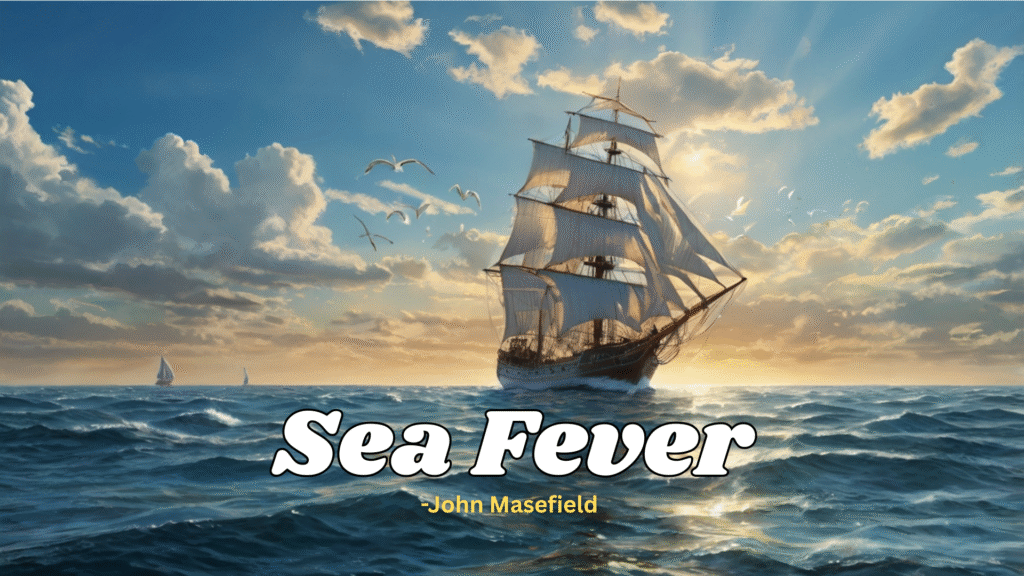
‘Sea Fever’ by John Masefield Summary, Question Answer: Class 10 English Syllabus
জন মেসফিল্ডের রচিত “Sea Fever” কবিতাটি পশ্চিমবঙ্গ মাধ্যমিক শিক্ষা পর্ষদের (WBBSE) পাঠ্যক্রমে অন্তর্ভুক্ত একটি অত্যন্ত গুরুত্বপূর্ণ কবিতা। এই কবিতায় সমুদ্রযাত্রার প্রতি কবির গভীর আকর্ষণ, মুক্তির আকাঙ্ক্ষা এবং প্রকৃতির রূপ-রসের প্রতি ভালোবাসা প্রতিফলিত হয়েছে। এটি কেবলমাত্র একটি ভ্রমণের কথা নয়, বরং একজন মানুষের স্বাধীনতা ও আত্মানুসন্ধানের প্রতীক। শিক্ষার্থীদের কল্পনাশক্তি, অনুভূতিশীলতা ও ভাষার সৌন্দর্য অনুধাবনের ক্ষেত্রে এই কবিতাটি উল্লেখযোগ্য ভূমিকা পালন করে। পাশাপাশি কবিতাটির ছন্দ, চিত্রকল্প ও ভাবনার গভীরতা ইংরেজি সাহিত্যের প্রতি শিক্ষার্থীদের আগ্রহ তৈরি করতে সাহায্য করে। এই সব দিক থেকেই “Sea Fever” পশ্চিমবঙ্গ মাধ্যমিক স্তরের ছাত্রছাত্রীদের জন্য এক মূল্যবান পাঠ।
Sea Fever
I must go down to the seas again, to the lonely sea and the sky,
And all I ask is a tall ship and a star to steer her by;
And the wheel’s kick and the wind’s song and the white sail’s shaking,
And a grey mist on the sea’s face, and a grey dawn breaking.
I must go down to the seas again, for the call of the running tide
Is a wild call and a clear call that may not be denied;
And all I ask is a windy day with the white clouds flying,
And the flung spray and the blown spume, and the sea-gulls crying.
I must go down to the seas again, to the vagrant gypsy life,
To the gull’s way and the whale’s way where the wind’s like a whetted knife;
And all I ask is a merry yarn from a laughing fellow-rover,
And quiet sleep and a sweet dream when the long trick’s over.
Sea Fever by John Masefield Summary: Class 10 English Syllabus
In the poem Sea Fever, John Masefield expresses a deep longing for the sea and the life of a sailor. He desires to return to the wild, free life on the ocean, guided by the stars and the wind. The poet feels a strong connection with nature — the waves, the sky and the adventure of sailing. Through vivid imagery and rhythm, he shows how the call of the sea is irresistible. The poem reflects themes of freedom, adventure and a deep love for the natural world.
Sea Fever by John Masefield Summary in Bengali: Class 10 English Syllabus
জন মেসফিল্ডের লেখা "Sea Fever" কবিতায় কবি সমুদ্রযাত্রার প্রতি এক গভীর আকর্ষণ ও তীব্র বাসনা প্রকাশ করেছেন। তিনি আবারও নৌযাত্রায় ফিরে যেতে চান, যেখানে আছে খোলা আকাশ, বাতাসের টান ও ঢেউয়ের ডাক। কবির মনে হয়, সমুদ্রই তার প্রকৃত বাড়ি—যেখানে সে প্রকৃতির সান্নিধ্যে, মুক্ত ও নির্ভার জীবন উপভোগ করতে পারে। কবিতাটির ভাষা ছন্দময় ও চিত্রময়, যা পাঠকের মনে সমুদ্রের বিশালতা, সাহসিকতা এবং স্বাধীনতার অনুভূতি জাগিয়ে তোলে। এটি প্রকৃতিপ্রেম, দুঃসাহসিকতা ও মুক্তির আকাঙ্ক্ষার একটি চিত্রময় কবিতা।
📘 MCQs – "Sea Fever" by John Masefield: Class 10 English Syllabus
- Who is the poet of Sea Fever?
(a) William Wordsworth
(b) Robert Frost
(c) John Masefield
(d) W.B. Yeats
Answer: (c) John Masefield - What is the speaker longing for in the poem?
(a) Forest life
(b) Mountain view
(c) Sea voyage
(d) Desert adventure
Answer: (c) Sea voyage - What does the speaker call a “wild call and a clear call”?
(a) The mountain's echo
(b) The sea’s invitation
(c) The bird’s song
(d) The captain’s order
Answer: (b) The sea’s invitation - What does the poet want to steer?
(a) A ship
(b) A bicycle
(c) A car
(d) A submarine
Answer: (a) A ship - What natural elements are frequently mentioned in the poem?
(a) Snow and storm
(b) Sun and stars
(c) Wind and sky
(d) Rain and thunder
Answer: (c) Wind and sky - What kind of life does the speaker desire?
(a) A quiet life
(b) A city life
(c) A free and adventurous life
(d) A peaceful mountain life
Answer: (c) A free and adventurous life - “And all I ask is a tall ship and a star to steer her by.” What is the ‘star’ symbolic of?
(a) Dreams
(b) Wealth
(c) Direction or guidance
(d) Power
Answer: (c) Direction or guidance - What sound does the poet mention from the sea?
(a) Cry of dolphins
(b) Roar of the whale
(c) Wind’s song and white sail’s shaking
(d) Clapping of waves
Answer: (c) Wind’s song and white sail’s shaking
‘Sea Fever’ by John Masefield Summary, Question Answer: Class 10 English Syllabus
- What time of the day is mentioned in the poem?
(a) Midnight
(b) Dawn
(c) Afternoon
(d) Twilight
Answer: (b) Dawn - What does the poet ask for at the end of his journey?
(a) A book and a light
(b) A warm fire
(c) A quiet sleep and a sweet dream
(d) A feast and a song
Answer: (c) A quiet sleep and a sweet dream - What feeling does the word “fever” in the title suggest?
(a) Illness
(b) Excitement and longing
(c) Anger
(d) Sadness
Answer: (b) Excitement and longing - What does the poet associate with adventure?
(a) War
(b) Battle
(c) The sea
(d) The jungle
Answer: (c) The sea - The poet compares life on land to life at:
(a) Sky
(b) River
(c) Sea
(d) Forest
Answer: (c) Sea - Which of these is NOT mentioned in the poem?
(a) Star
(b) Sail
(c) Tide
(d) Sandstorm
Answer: (d) Sandstorm - The speaker wants to hear the __________ in the wind.
(a) laughter
(b) crying
(c) song
(d) roar
Answer: (c) song - What kind of companions does the poet wish for?
(a) Gentle and shy
(b) Loud and powerful
(c) Merry and friendly
(d) Quiet and distant
Answer: (c) Merry and friendly - The phrase “vagrant gypsy life” suggests:
(a) Wealthy life
(b) Lazy life
(c) Free and wandering life
(d) Royal life
Answer: (c) Free and wandering life - What does “whetted knife” imply?
(a) Dullness
(b) Sharpness and readiness
(c) Decoration
(d) Playfulness
Answer: (b) Sharpness and readiness - What does the word “yarn” mean in the poem?
(a) Thread
(b) Story
(c) Rope
(d) Cloth
Answer: (b) Story
‘Sea Fever’ by John Masefield Summary, Question Answer: Class 10 English Syllabus
- What does the poet ask for in the morning?
(a) A walk
(b) A song and a laugh
(c) A book and tea
(d) A ship and a map
Answer: (b) A song and a laugh - The tone of the poem is:
(a) Sad
(b) Angry
(c) Longing and romantic
(d) Humorous
Answer: (c) Longing and romantic - The poem “Sea Fever” is a:
(a) Narrative poem
(b) Sonnet
(c) Lyric poem
(d) Ballad
Answer: (c) Lyric poem - How many stanzas does “Sea Fever” have?
(a) Two
(b) Three
(c) Four
(d) Five
Answer: (b) Three - The word “grey mist” refers to:
(a) A painting
(b) Early morning fog
(c) Sunset
(d) Rain
Answer: (b) Early morning fog - What does the poet wish for at the end of his life?
(a) Fame
(b) Riches
(c) Rest and peace
(d) Power
Answer: (c) Rest and peace - Which of the following best describes the central theme of the poem?
(a) City life
(b) Nature’s cruelty
(c) Longing for the sea and freedom
(d) Fear of loneliness
Answer: (c) Longing for the sea and freedom - The phrase “call of the running tide” suggests:
(a) A noise in the city
(b) Natural rhythm of the sea
(c) A shouting person
(d) A crying baby
Answer: (b) Natural rhythm of the sea - “Sea Fever” belongs to which literary period?
(a) Romantic
(b) Victorian
(c) Modernist
(d) Post-modern
Answer: (b) Victorian - The poem is written in which person?
(a) First person
(b) Second person
(c) Third person
(d) None
Answer: (a) First person
‘Sea Fever’ by John Masefield Summary, Question Answer: Class 10 English Syllabus
- What does the poet want “before the long trick’s over”?
(a) A meal
(b) A party
(c) Quiet sleep and sweet dreams
(d) A medal
Answer: (c) Quiet sleep and sweet dreams - The phrase “white sail’s shaking” indicates:
(a) A storm
(b) Wind’s pressure on the sail
(c) Fire
(d) Calm weather
Answer: (b) Wind’s pressure on the sail - “A star to steer her by” refers to:
(a) A starfish
(b) Star map
(c) Navigation using the stars
(d) A compass
Answer: (c) Navigation using the stars - Which of the following words best matches the poet’s tone?
(a) Bored
(b) Enthusiastic
(c) Angry
(d) Confused
Answer: (b) Enthusiastic - The poet wants to hear the wind's song and...
(a) The sea's moan
(b) The gull's cry
(c) The sail’s shaking
(d) The oar’s splash
Answer: (c) The sail’s shaking - What natural object does the poet refer to when speaking of the “blown spume”?
(a) Sand
(b) Snow
(c) Sea foam
(d) Rain
Answer: (c) Sea foam - What kind of weather does the poet describe?
(a) Snowy
(b) Foggy and windy
(c) Sunny and dry
(d) Rainy
Answer: (b) Foggy and windy - “The wheel’s kick” symbolizes:
(a) Boat movement
(b) A car’s motion
(c) A child’s game
(d) Storm damage
Answer: (a) Boat movement - Why does the poet desire a “merry yarn”?
(a) For sleep
(b) For entertainment
(c) To remember old times
(d) For celebration
Answer: (c) To remember old times - The speaker's desire to return to the sea is driven by:
(a) Habit
(b) Fear
(c) Deep emotional connection
(d) Boredom
Answer: (c) Deep emotional connection - Which of these is a poetic device used in the poem?
(a) Hyperbole
(b) Pun
(c) Alliteration
(d) Irony
Answer: (c) Alliteration
‘Sea Fever’ by John Masefield Summary, Question Answer: Class 10 English Syllabus
- "The gull’s way and the whale’s way" refers to:
(a) Sea routes of birds and whales
(b) Games
(c) Land animals
(d) Direction signs
Answer: (a) Sea routes of birds and whales - Which image represents peace in the poem?
(a) The grey dawn
(b) The quiet sleep
(c) The white sail
(d) The tall ship
Answer: (b) The quiet sleep - Why does the poet long for the sea?
(a) He misses friends
(b) He wants rest
(c) He feels a natural pull to the sea
(d) He is lost
Answer: (c) He feels a natural pull to the sea - What is the rhyme scheme of the poem?
(a) AABB
(b) ABAB
(c) ABCB
(d) Free verse
Answer: (b) ABAB - What mood is created by the use of “grey dawn breaking”?
(a) Joy
(b) Calm and reflective
(c) Anger
(d) Confusion
Answer: (b) Calm and reflective - “A windy day with the white clouds flying” – what does this line show?
(a) Storm
(b) Fast movement in the sky
(c) Sunset
(d) Summer afternoon
Answer: (b) Fast movement in the sky - The poem celebrates which aspect of life?
(a) Luxury
(b) Duty
(c) Adventure and freedom
(d) Power
Answer: (c) Adventure and freedom
‘Sea Fever’ by John Masefield Summary, Question Answer: Class 10 English Syllabus
- Which of these is used as a metaphor for life?
(a) Ship’s journey
(b) Seagull’s cry
(c) Wind’s song
(d) Sea foam
Answer: (a) Ship’s journey - The final wish of the poet shows his:
(a) Fear of death
(b) Acceptance of death with peace
(c) Anger at life
(d) Hope for rebirth
Answer: (b) Acceptance of death with peace - “Sweet dreams when the long trick’s over” refers to:
(a) A sailor’s rest after a journey
(b) A birthday party
(c) A school exam
(d) A dream vacation
Answer: (a) A sailor’s rest after a journey
✍ Fill in the Blanks "Sea Fever" by John Masefield: Class 10 English Syllabus
- “I must go down to the seas again, to the _____ and the sky.”
Answer. sea - “And all I ask is a tall _____ and a star to steer her by.”
Answer. ship - “And the wheel’s kick and the wind’s song and the white sail’s _____.”
Answer. shaking - “And a grey mist on the sea’s face, and a grey dawn _____.”
Answer. breaking - “I must go down to the seas again, for the call of the running _____.”
Answer. tide - “Is a wild call and a clear call that may not be _____.”
Answer. denied - “And all I ask is a windy day with the white clouds _____.”
Answer. flying
‘Sea Fever’ by John Masefield Summary, Question Answer: Class 10 English Syllabus
- “And the flung spray and the blown _____, and the sea-gulls crying.”
Answer. spume - “And all I ask is a merry yarn from a laughing fellow-_____.”
Answer. rover - “And quiet sleep and a sweet _____ when the long trick’s over.”
Answer. dream - The poet wants a star to _____ the ship by.
Answer. steer - The “long trick” in the poem symbolizes _____.
Answer. life - The poet compares life to a long _____ at sea.
Answer. journey - The poem expresses a strong longing for the _____.
Answer. sea - “Sea Fever” is a _____ poem filled with emotion.
Answer. lyric - The word “spume” refers to sea _____.
Answer. foam - The poet wishes for a _____ life, like a gypsy.
Answer. vagrant - The poem uses the natural imagery of wind, tide, and _____.
Answer. sky - The poet describes the sky as _____.
Answer. lonely - The rhyme scheme of “Sea Fever” is _____.
Answer. ABAB - The poem contains three _____ of four lines each.
Answer. stanzas - The word “yarn” in the poem means a _____.
Answer. story
‘Sea Fever’ by John Masefield Summary, Question Answer: Class 10 English Syllabus
- “Sea Fever” celebrates the adventurous spirit of a _____.
Answer. sailor - The poet expresses a desire to sail again in a _____ ship.
Answer. tall - The “call” of the sea is described as wild and _____.
Answer. clear - The gull’s way and the whale’s way refer to the life of the _____.
Answer. sea - The poet asks for a “laughing” fellow-rover, suggesting _____.
Answer. companionship - The mood of the poem is one of deep emotional _____.
Answer. longing - The imagery of “grey dawn breaking” suggests early _____.
Answer. morning - The poet hears the “wind’s _____.”
Answer. song - The sea’s face is covered in grey _____ and mist.
Answer. fog - “Sea Fever” reflects Masefield’s love for the _____.
Answer. ocean - “Tall ship” is a metaphor for the poet’s journey through _____.
Answer. life - The speaker wants to feel the ship’s “wheel’s _____.”
Answer. kick - The ship is guided not by machines but by a _____ in the sky.
Answer. star - The phrase “vagrant gypsy life” suggests a life of _____.
Answer. freedom - The poet asks for a quiet _____ after his journey ends.
Answer. sleep - The gull’s cry and the wind’s sound are part of the poet’s _____.
Answer. longing - The sail is described as “white” and _____.
Answer. shaking - “Sweet dreams” at the end symbolize peaceful _____.
Answer. death - The speaker finds joy in the simple sounds of the _____.
Answer. sea - “Blown spume” describes the sea’s _____ during strong wind.
Answer. foam - “Call of the tide” cannot be _____.
Answer. denied
‘Sea Fever’ by John Masefield Summary, Question Answer: Class 10 English Syllabus
- The sea’s call is irresistible to the _____.
Answer. poet - The speaker compares himself to a _____, roaming freely.
Answer. gypsy - The poem emphasizes the power and beauty of the _____.
Answer. natural world - The speaker wants to live a life full of _____.
Answer. adventure - “Sea Fever” is filled with vivid and powerful _____.
Answer. imagery - The poet’s final wish is to die in _____ and peace.
Answer. sleep - The sea represents freedom, mystery, and _____.
Answer. escape
✍Short Answer Questions (SAQs) – "Sea Fever" by John Masefield: Class 10 English Syllabus
- Who wrote the poem “Sea Fever”?
Answer. John Masefield. - What does the poet long for in the poem?
Answer. He longs to go back to the sea. - What is a “tall ship” in the poem?
Answer. It refers to a large sailing ship. - Why does the poet need a star?
Answer. To steer the ship as a guide for direction. - What natural call does the poet mention?
Answer. The call of the running tide. - How does the poet describe the sea?
Answer. Wild, free and irresistible. - What does the “wheel’s kick” symbolize?
Answer. The ship's steering movement and adventure. - Which time of day is described in the first stanza?
Answer. Early morning (grey dawn breaking). - What does the poet ask for on a windy day?
Answer. White clouds flying, flung spray and the sea-gull’s cry. - What does “blown spume” refer to?
Answer. Sea foam carried by wind.
‘Sea Fever’ by John Masefield Summary, Question Answer: Class 10 English Syllabus
- What does the poet want to hear?
Answer. The wind’s song and the white sail’s shaking. - What is meant by the phrase “vagrant gypsy life”?
Answer. A free, adventurous and roaming lifestyle. - Why does the poet call the sea’s call ‘clear and wild’?
Answer. It represents his strong inner desire. - What kind of companions does the poet wish for?
Answer. A laughing fellow-rover. - What does “quiet sleep” in the poem symbolize?
Answer. Peaceful death after a life’s journey. - Why does the poet want a “merry yarn”?
Answer. To share joyful stories with companions. - What is the theme of the poem?
Answer. A longing for freedom, adventure and connection with nature. - How many stanzas does the poem have?
Answer. Three. - What is the rhyme scheme of “Sea Fever”?
Answer. ABAB. - What kind of poem is “Sea Fever”?
Answer. A lyric poem. - What kind of imagery is used in the poem?
Answer. Natural and nautical imagery. - What is the mood of the poem?
Answer. Nostalgic and passionate. - What sound does the poet want to hear at sea?
Answer. Wind’s song and sail’s shaking. - What is “spume”?
Answer. Sea foam.
‘Sea Fever’ by John Masefield Summary, Question Answer: Class 10 English Syllabus
- What does “star to steer her by” suggest?
Answer. Navigation using natural guidance. - What is the “long trick” in the poem?
Answer. A metaphor for life’s long journey. - What does the poet seek at the end of the poem?
Answer. Quiet sleep and sweet dreams. - What does “grey mist” suggest?
Answer. A foggy, early morning atmosphere. - Why does the poet call the sea “lonely”?
Answer. It shows a deep emotional connection with solitude. - What kind of life does the poet prefer?
Answer. A free, adventurous life on the sea. - What is the significance of the gull’s cry in the poem?
Answer. It adds to the realistic and emotional atmosphere of the sea. - How does the poet describe the clouds?
Answer. White clouds flying. - What kind of journey is described in the poem?
Answer. A sea voyage symbolizing life’s journey. - What does the ship represent in the poem?
Answer. Life and the journey through it. - What does the speaker compare his journey to?
Answer. A sailor’s long voyage. - Why is the title “Sea Fever” appropriate?
Answer. It reflects the strong passion and craving for the sea. - What emotion drives the poem?
Answer. Longing and desire for adventure. - Why does the poet choose the sea over land?
Answer. Because of his deep connection and longing for freedom.
‘Sea Fever’ by John Masefield Summary, Question Answer: Class 10 English Syllabus
- How is nature important in this poem?
Answer. Nature guides, inspires, and comforts the poet. - What is meant by “white sail’s shaking”?
Answer. The movement of the sail due to wind. - What does the poet want to escape from?
Answer. Possibly the routine or limitations of life on land. - What role does the sea play in the poet’s life?
Answer. It is a place of freedom, joy, and spiritual connection. - What feeling does the poem evoke in readers?
Answer. A longing for nature and freedom. - Why does the poet repeat “I must go down to the seas again”?
Answer. To emphasize his strong emotional pull to the sea. - How does the poem connect life and death?
Answer. Life is like a voyage, and death is the final peaceful rest.
‘Sea Fever’ by John Masefield Summary, Question Answer: Class 10 English Syllabus
- What is the poet’s tone in the poem?
Answer. Reflective and yearning. - What kind of “dream” does the poet ask for?
Answer. A sweet dream after death. - What makes the sea magical for the poet?
Answer. Its beauty, sound, and sense of freedom. - Why is the sea personified in the poem?
Answer. To show its deep emotional significance to the poet. - How does the poem end?
Answer. With a desire for peaceful rest after life’s journey.
জন মেসফিল্ডের “Sea Fever” কবিতাটি ক্লাস 10 এর পাঠ্যসূচির একটি গুরুত্বপূর্ণ অংশ। এই কবিতায় মানুষের সমুদ্রের প্রতি গভীর আকাঙ্ক্ষা ও স্বাধীনতার বাসনা প্রকাশ পায়। এটি পাঠকদের কল্পনা শক্তি বাড়ায় এবং প্রকৃতির সৌন্দর্যের সঙ্গে মানব মনোরঞ্জনের সম্পর্ক বোঝায়। কবিতাটি ছেলেমেয়েদের সাহসী হওয়ার, নতুন অভিজ্ঞতার সন্ধান করার এবং জীবনের গতিময়তায় নিজেকে খুঁজে পাওয়ার শিক্ষা দেয়। তাই এটি শিক্ষার্থীদের মানসিক বিকাশ এবং সৃজনশীল চিন্তার জন্য অত্যন্ত মূল্যবান।
🔔 পরবর্তী আপডেট সম্পর্কে গুরুত্বপূর্ণ তথ্য:
এই প্রশ্নোত্তর তালিকায় ভবিষ্যতে যদি আরও নতুন প্রশ্ন যোগ করা হয়, তাহলে তোমরা এখানেই আপডেট পেয়ে যাবে। পাশাপাশি, আমাদের Topperstrack.in অ্যাপ-এর কোর্সে তোমরা পাবে –
✅ সাজেশন, উত্তরপত্র এবং রিভিশন সেট
✅ অধ্যায়ভিত্তিক স্টাডি রিসোর্স
✅ নিয়মিত মক টেস্ট ও কুইজ
🔔 পড়াশোনাকে আরও সহজ ও মজাদার করতে আমাদের সঙ্গেই থাকুন!
✅ এখনই যুক্ত হোন আমাদের 📚 Study Group-এ, যেখানে প্রতিদিন পাবেন গুরুত্বপূর্ণ নোটস, MCQ প্রশ্ন, সাজেশন এবং পরীক্ষা প্রস্তুতির টিপস!
👉 টেলিগ্রাম গ্রুপে যুক্ত হতে ক্লিক করুন:
📲 Join Telegram
👉 হোয়াটসঅ্যাপ চ্যানেলে যুক্ত হতে ক্লিক করুন:
📲 Join WhatsApp Channel
🎯 পড়াশোনা হোক আরও সহজ, গাইডলাইন থাক আমাদের সঙ্গেই!
👥 বন্ধুদের সাথেও শেয়ার করতে ভুলবেন না! 📖✨
💡 এছাড়াও আমাদের অফিসিয়াল ওয়েবসাইট 🌐 Topperstrack.in
এ গেলে তোমরা আরও অনেক বিষয়ভিত্তিক প্রস্তুতি ও শিক্ষনীয় সামগ্রী পাবে!
📱 তাই দেরি না করে এখনই Topperstrack.in অ্যাপ ডাউনলোড করো এবং Topperstrack.in -এ ভিজিট করে নিয়মিত প্র্যাকটিসে থাকো।



